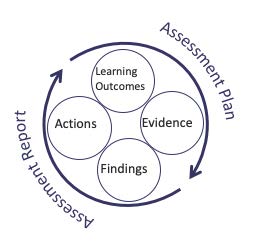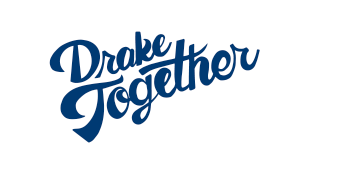Program Assessment
As goal-oriented academic programs, Drake academic programs identify the skills and abilities they expect students to possess when they graduate, and regularly review and reflect upon students’ ability to achieve these outcomes.
Understanding Program Assessment at Drake
What do you mean by assessment? How do I assess student learning? What exactly do you want me to do?
When we talk about assessment at Drake, we refer to intentional and critical reflection on student learning through a program lens. This is a four-step process: (1) Learning Outcomes, (2) Evidence, (3) Findings, and (4) Action. Steps 1 and 2 are part of your Assessment Plan, and steps 3 and 4 are part of your Assessment Report.
At Drake, high quality assessment satisfies six criteria:

Assessment Plans should:
- Identify outcome(s) of focus
- Gather evidence that addresses outcome(s)
- Indicate when faculty will meet to reflect on evidence
Assessment Reports should:
- Analyze findings
- Develop a plan of action
- Implement the plan and report on the status
The program assessment process is owned by each individual college/school and the respective Associate Deans and Department Chair or Program Lead.
Learning From Your Colleagues
What have my peers at Drake set as their learning outcomes? What strategies have worked for my colleagues across campus? How are the other academic programs at Drake regularly reflecting on student learning?
You can learn a lot about assessment by reviewing the work of your peers. Academic degree programs identify the specific knowledge, skills, and abilities that students should have when they complete their program.
Drake Student Learning Outcomes
Programs submit annual review and reflection on student learning to their Dean/Associate Dean. Here are some examples of how your colleagues are doing and using assessment:
• Guided Inquiry The History program used Guided Inquiry Protocol to have an intentional conversation about its learning outcomes centered on specific samples of student work from the capstone.
• Embedded Assessment The Data Analytics program uses specific assignment embedded within the curriculum as evidence of student’s achievement of learning outcomes.
• Use of Rubrics The MBA program uses rubrics to identify target levels of performance for their students and to diagnose why students might perform below proficiency.
• Closing the Loop The STEM Education program identifies program actions to improve student learning that address the specific gaps that the program identified.
Submitting Assessment Reports
Where does this all live? Can I review other programs’ reports?
All Drake faculty and staff have access to review and submit assessment information for their program. This occurs on a cycle decided by your college/school.
Program Assessment Resources
• Collaborative Guided Inquiry The Guided Inquiry Protocol is an assessment framework that provides opportunity for faculty to discuss student work in an intentional way centered around learning outcomes.
• Curriculum Mapping A curriculum map allows a program to visually represent and align the program’s student learning outcomes to the program’s course progression, and allows the program to see how a student’s skills and abilities might progressively accumulate throughout the curriculum.
• Understanding by Design/Backward DesignThe Understanding by Design (UbD®) framework was created by Grant Wiggins and Jay McTighe to guide faculty to develop and implement a curriculum built around learning outcomes.
o Overview of the UBD Framework
o UBD Template
• Co-curricular Programs Assessment Worksheet The Council on Leadership Development developed an assessment worksheet to help co-curricular programs walk through how to assess one of their program’s learning outcomes.

